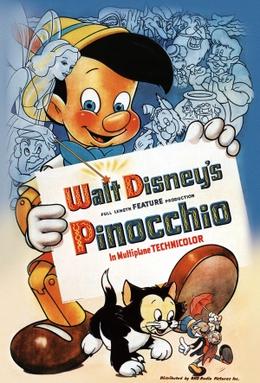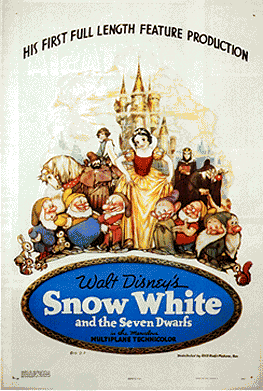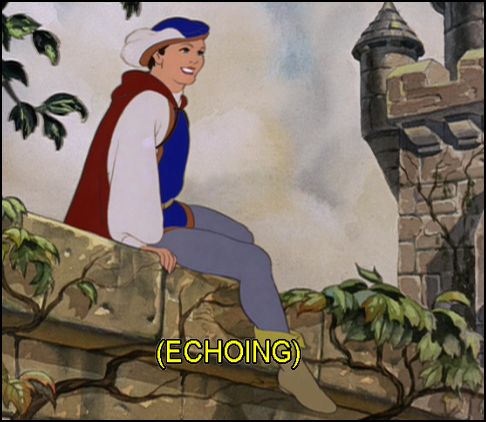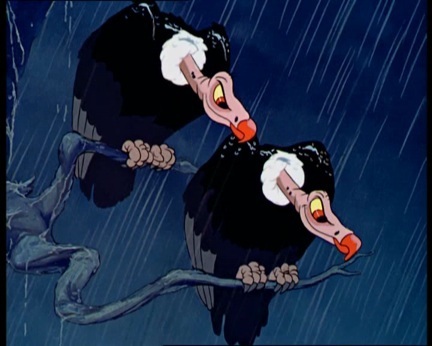To begin with, Pinocchio is a bizarre story to choose. The original Italian novel is pretty dark--Geppetto beats Pinocchio on a regular basis, and Pinocchio is a manic, often malicious, impish creature who manages to get Geppetto arrested by the end of the first chapter and Jiminy Cricket squished by the end of second. (Yes, you heard me right--in the original, the cricket conscience gets squished. Early on. R, who is Italian and understands how his countrymen think, tells me that this is why Pinocchio goes on to be such a bad boy, because his conscience got squashed. I guess that makes sense.) So as dark as Grimm fairy tales can be, this one is an even less obvious choice for a Disney movie.
As a Disney movie, Pinocchio gets cleaned and lightened up a lot (something Disney will excel at in pretty much every movie since), but it's still a little weird. It is, after all, about a lonely old man fantasizing his puppet into being. And the plot doesn't quite flow as much as one would like, but more on that below. Overall, Disney clearly had fixed several things since Snow White, but still had a ways to go yet.
Background
Historical Context
I think we can all agree that the year 1940 was a pretty big deal when it comes to world history, what with World War II happening and all--but when Pinocchio was released in February, not much had happened yet. I think it's safe to imagine that everyone was feeling a little tense, however.
"Making Of" Notes
As I mentioned before, Pinocchio the novel is pretty bizarre, but for some reason Walt Disney was delighted by it (having read it per the recommendation of a colleague during the making of Snow White) and was determined to make it into a movie. It was supposed to come after Bambi, but Bambi got held up because of technical difficulties.
Apparently, early on, Pinocchio was much closer to the original novel, both in plot and characters. There were many more plot points preserved from the original story (not unlike the early versions of Snow White), Pinocchio himself was more of a sarcastic, mischievous, wise guy like Charlie McCarthy, and both he and Jiminy Cricket were drawn realistically.
But then Disney realized that, hey, live puppets are pretty creepy and so are bugs, and nobody is going to be rooting for a possessed doll (Chuckie was still some decades away) (but who roots for Chuckie anyway?). So Pinocchio got a button nose, Mickey Mouse style gloves, and a charming innocence to explain away his mischief, and Jiminy got a suit, an egg head, and a lead role.
Animation
The animation is worlds away from the dreamy, watercolor look of Snow White and looks already much more like the classic animated features that we remember. The only time I took particular note of the animation was while watching the Blue Fairy, who was animated with a rotoscope, like Snow White had been. (Clearly Disney still wasn't comfortable with animating pretty ladies.) The most notable scene, animation-wise, was Monstro the Whale, which had truly amazing water effects.
And here's a question--why is an Italian story set in Bavarian Germany? See: lederhosen, Tyrolean hat, all those cuckoo clocks. Odd choice, Mr. Disney. Cute, but odd.
Plot
And here's a question--why is an Italian story set in Bavarian Germany? See: lederhosen, Tyrolean hat, all those cuckoo clocks. Odd choice, Mr. Disney. Cute, but odd.
Plot
The plot is where Pinocchio got a little mystifying. I have nothing but the fondest memories of watching Pinocchio when I was little, but it hasn't aged well. It started out promisingly, with Geppetto working on his puppet and some comic sequences of Figaro the kitten and Cleo fish. (Figaro, like all of Disney's animals, was excellently animated!) However, as the movie proceeds, the plot starts getting fragmented, disconnected. One scene follows the other without much transition: Pinocchio meets the cat and the fox, Pinocchio ends up performing for Stromboli, Pinocchio gets imprisoned and gets saved by the Blue Fairy, Pinocchio ends up going on a cart...as a child slave...? It doesn't make much sense, there's not much story arc, and feels like a series of shorts rather than a cohesive film. Which leads us to...
Characters
The film has a rather large number of characters, thanks to the episodic nature of the plot. There's not even one real villain--is it Stromboli or Honest John the fox? Is it that creepy child slaver who changes them to donkeys? Is it Monstro? Isn't he just doing what whales do, though? For that matter, there isn't really a hero, either.
Pinocchio - Pinocchio is just a kid. Like Snow White, he's pretty astoundingly stupid, but at least he has the excuse of being a child and, you know, made out of wood. There's not much else to him. He doesn't have much personality.
Jiminy Cricket - Arguably the real protagonist of the film, as he gives the opening narration and starts the film from his point of view. I remember his as a wise little cricket, the embodiment of the word "Conscience," but actually he's pretty reluctant to take on the role in the first place, and does a pretty crappy job throughout. He even abandons Pinocchio to his fate at one point. Kind of like a clueless uncle who suddenly finds himself in charge of a wayward nephew and doesn't really know what to do. He expects too much of a juvenile puppet with wood for brains in one scene, and then doesn't give him enough credit in the next. For a protagonist, he's not much of a hero.
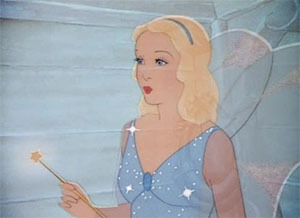

Geppetto - Sweet, a little pathetic for falling in love with his own puppet.

Blue Fairy - Does absolutely nothing except admonish Pinocchio to be good and then reward him even when he's not. Classic enabler.
The Animals/Sidekicks: Figaro and Cleo save the film. Instead of re-watching Pinocchio, just treat yourself to this sing-along song, or this short from 1943.
So, no distinguishable heroes or villains. No wonder nobody in our small viewing audience was enamored.
Music
The score is where Pinocchio really stands out. There are only four, but apart from "Give a Little Whistle" which you might or might not remember, "I've Got No Strings" and "Hi Diddle-Dee-Dee (An Actor's Life For Me)" are memorable ones. But nothing compares to...
Most Memorable Song...Ever
"When You Wish Upon a Star" was so popular, reaching the top five in Billboard's Record Buying Guide, that it became the theme song of the Walt Disney television series in the 1950s, the musical sting that accompanies the Disney icon at the beginning of all Disney productions, and pretty much as iconic as Mickey Mouse and the Disney castle. Later, it was rated in the AFI's 100 Greatest Songs in Film History, along with "Some Day My Prince Will Come." Funnily enough, very few people remember that it originated in Pinocchio.
Runner Up
"I've Got No Strings." I've always liked this one! So weird. So delightful.
Reviews
From the New York Times, February 8, 1940 (Frank S. Nugent disagrees with me)
So, Pinocchio was a disappointment and almost completely derailed my plan to watch all the Disney movies. We will move on, however, in anticipation of masterpieces like Bambi and (husband's personal favorite) Dumbo. But first things first: Fantasia is next! Break out the mind-altering substances, this is going to be fun.
Characters
The film has a rather large number of characters, thanks to the episodic nature of the plot. There's not even one real villain--is it Stromboli or Honest John the fox? Is it that creepy child slaver who changes them to donkeys? Is it Monstro? Isn't he just doing what whales do, though? For that matter, there isn't really a hero, either.
Pinocchio - Pinocchio is just a kid. Like Snow White, he's pretty astoundingly stupid, but at least he has the excuse of being a child and, you know, made out of wood. There's not much else to him. He doesn't have much personality.
Jiminy Cricket - Arguably the real protagonist of the film, as he gives the opening narration and starts the film from his point of view. I remember his as a wise little cricket, the embodiment of the word "Conscience," but actually he's pretty reluctant to take on the role in the first place, and does a pretty crappy job throughout. He even abandons Pinocchio to his fate at one point. Kind of like a clueless uncle who suddenly finds himself in charge of a wayward nephew and doesn't really know what to do. He expects too much of a juvenile puppet with wood for brains in one scene, and then doesn't give him enough credit in the next. For a protagonist, he's not much of a hero.

Geppetto - Sweet, a little pathetic for falling in love with his own puppet.

Blue Fairy - Does absolutely nothing except admonish Pinocchio to be good and then reward him even when he's not. Classic enabler.
The Animals/Sidekicks: Figaro and Cleo save the film. Instead of re-watching Pinocchio, just treat yourself to this sing-along song, or this short from 1943.
So, no distinguishable heroes or villains. No wonder nobody in our small viewing audience was enamored.
Music
The score is where Pinocchio really stands out. There are only four, but apart from "Give a Little Whistle" which you might or might not remember, "I've Got No Strings" and "Hi Diddle-Dee-Dee (An Actor's Life For Me)" are memorable ones. But nothing compares to...
Most Memorable Song...Ever
Runner Up
"I've Got No Strings." I've always liked this one! So weird. So delightful.
Reviews
From the New York Times, February 8, 1940 (Frank S. Nugent disagrees with me)
If Westbrook Pegler could write (as he did write in January, 1938) that Walt Disney's "Snow White" was the happiest event since the armistice, we can report confidently this morning that Mr. Disney's "Pinocchio" is the happiest event since the war. His second feature-length cartoon, three years in the making and the occasion of the Center Theatre's return to the cinema's ranks, is a blithe, chuckle-some, witty, fresh and beautifully drawn fantasy which is superior to "Snow White" in every respect but one: its score. And, since its score is merry and pleasant, if not quite so contagiously tuneful as the chorals of the seven little men who really weren't there, we shall not have it stressed to "Pinocchio's" disparagement. It still is the best thing Mr. Disney has done and therefore the best cartoon ever made.From Variety, Sun. Dec. 31, 1939
Seeing a Disney work in action always is more fun than analyzing it, for charm is a quality even Barrie could not define and charm is the pulsating, radiant, winning something that shines through this latest Disney creation and makes it so captivating. It isn't at all self-conscious or calculating, like the charm of the matinee idol or honeyed radio voice; it seems almost too spontaneous for us to credit the fact that every bit of it was conceived, weighed, worked out during a three-year gestation period in a cartoon factory. At the risk of being, of all hateful words, sentimental, we would say "Pinocchio" is the work of men of goodwill and good fellowship. From Disney down to his least inker, animator or air-brush wielder, we sense a guild of craftsmen smiling over their drawing boards and paintpots, delighted with the make-believe world they are creating.
The make-believe here, of course, is basically of Collodi's imagining. It was his notion, in a quaint and moral-pointing fairy tale, to tell of a long-nosed boylike puppet, dubbed Pinocchio by Gepetto, the woodcarver, who was brought to life by the Blue Fairy but told he could not be a real little boy until he had acquired truth, courage and unselfishness. To assist him in his quest, she provided him with a conscience in the form of a cricket—Jiminy Cricket to Mr. Disney's fantastic crew—and there were adventures with a cruel puppetmaster, encounters with a wicked Fox and a Cat, a bewitched sojourn on Pleasure Island, where wayward little boys turned into jackasses, and, finally, an exciting descent to the ocean's floor to rescue poor Gépetto from the belly of a whale. All grist, obviously, to the Disney mill.
And he has had an impish, a scampish, a quizzical and disarmingly whimsical time with it from the moment his Jiminy Cricket (who acts as a debonair tourist guide through this wonderland) opens the pages of his fantasy to that, at the very end, when Figaro, the kitten, jumps into the goldfish bowl to plant an ecstatic and suspiciously fishy kiss on the cupid's-bow lips of Cleo, the kittenish goldfish. For all these curious folk and all their curious adventures have been drawn with Mr. Disney's invariably quick eye to amusing characterization and humorous detail, with his usual relish for a sly little joke, with his habitual enjoyment of telling whoppers and making them seem just as natural as a cricket in spats.
His Jiminy Cricket, as you might have guessed, is the Dopey of "Pinocchio," and for just the opposite reasons. He's smart as a cricket and twice as chirpy. It's something to hear him rap with his cane on the teeth of Monstro the Whale and demand admittance into the Blue Grottoed belly where Gepetto, perched on the rail of a swallowed derelict, is manfully fishing for tuna. It's something, too, to see the expression of annoyance drift across his face, glacier-like, when Gepetto's clocks begin to hammer out the seconds he meant to pass in sleep. "Quiet!" he bellows, like an assistant director, and every pendulum freezes in mid-swing. No question about it, Jiminy Cricket has a commanding presence and the droll voice of Cliff Edwards, who can burlesque a tenor with the worst of them.
But it isn't easy to call Jiminy the only favorite. Pinocchio is a fresh little cuss, Cleo the Goldfish is a dream and Figaro the kitten is the kind of kitten only Disney's men could draw, exact to the whistling purr, the wicked side-glance, the bewildered and hurt look when the hand that has been scratching its neck suddenly is withdrawn. You'll like Mr. Disney's cast, from cricket to Monstro, from kitten to Fox, from Gepetto to goldfish.
Technically, and we hate to be technical at a time like this, it answers every one of the objections raised when "Snow White" was shown. The drawing is finer, with none of the line-straying noticeable when Prince Charming and his Cinderella took the screen. The handling of shadows and highlights is surer, and the color-lovely as it was in Disney's first cartoon feature—is immeasurably lovelier here. We note, too, with vast admiration, evidences of true direction—freer use of camera in panning, zoom shot and dollying, so that the vantage point is not fixed but travels to and from and with the subjects in its range. Some uses of it are cute, too—like the camera's hopping toward a scene when little Jiminy is telling us how he hopped over to take a look in Gepetto's window.
But that's enough about technique. Its refinement was inevitable, for Mr. Disney is a notorious perfectionist; we've no doubt he is dissatisfied still and will have even greater marvels for us in his "Fantasia," the next of his promised features. What really matters, and all that matters, this morning is that "Pinocchio" is here at last, is every bit as fine as we had prayed it would be—if not finer—and that it is as gay and clever and delightful a fantasy as any well-behaved youngster or jaded oldster could hope to see.
Pinocchio is a substantial piece of entertainment for young and old. Both animation and photography are vastly improved over Walt Disney's first cartoon feature, Snow White. Animation is so smooth that cartoon figures carry impression of real persons and settings rather than drawings.Extensive use of the Disney-developed multiplane camera (first used moderately for Snow White) provides some ingenious cartoon photography, allowing for camera movement similar to dolly shots. Most startling effect is the jumpy landscape as seen through the eyes of a leaping Jiminy Cricket.
Opening is similar to Snow White, establishing at the start that this is a fairy tale. Jiminy, witty, resourceful and effervescing cricket, displays the title cover and first illustrations of the book with a dialog description introducing the old woodcarver, Geppetto, and his workshop. Place abounds with musical clocks and gadgets, pet kitten and goldfish - and the completed puppet whom he names Pinocchio. Geppetto's wish for a son on the wishing star is granted when the blue fairy appears and provides life for the puppet; with Jiminy Cricket appointed guardian of latter's conscience. Pinocchio soon encounters villainous characters and his impetuous curiosity gets him into a series of escapades.
Cartoon characterization of Pinocchio is delightful, with his boyish antics and pranks maintaining constant interest. Jiminy Cricket is a fast-talking character providing rich humor with wisecracks and witticisms. Kindly old Geppetto is a definitely drawn character while several appearances of Blue Fairy are accentuated by novel lighting effects. Picture stresses evil figures and results of wrongdoing more vividly and to greater extent than Snow White, and at times somewhat overplays these factors for children. This is minor, however.
1940: Best Song ('When You Wish Upon a Star'), Original Score
The Husband's Review
"It was weird...meh. And Pinocchio's a jerk."
What We Would Have Been Watching If I Hadn't Hijacked The Netflix Queue:
It was months ago, but I'm pretty sure it was No Country for Old Men. Excellent movie! Sorry I hijacked it.
So, Pinocchio was a disappointment and almost completely derailed my plan to watch all the Disney movies. We will move on, however, in anticipation of masterpieces like Bambi and (husband's personal favorite) Dumbo. But first things first: Fantasia is next! Break out the mind-altering substances, this is going to be fun.
